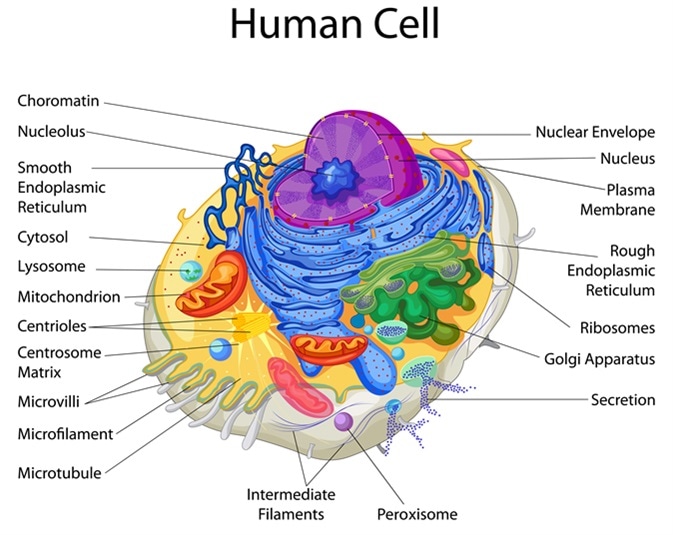Chromatin remodeling is an important mechanism of regulating eukaryotic gene expression, which makes tightly condensed DNA accessible to various regulatory factors, such as transcription factors and components of DNA replication.
What is Chromatin?
In the cell nucleus, the DNA double helix is tightly wrapped around nuclear proteins called histones. The complex formed by proteins and DNA is called chromatin. Tight wrapping of DNA around histones prevents its access to various chromosomal regulatory proteins, leading to gene silencing.
Chromatin has two forms: euchromatin, which is less condensed and can participate in transcription; and heterochromatin, which is highly condensed and cannot be transcribed. The basic unit of chromatin is the nucleosome, which is composed of 147 base pairs of DNA wrapped around 2 copies each of 4 histone proteins namely H2A, H2B, H3, and H4 (histone octamer). A small segment of free DNA exists between two subsequent nucleosomes, which give the chromosome an appearance similar to beads on a string.

Human cell diagram. Image Credit: Vecton / Shutterstock
Mechanism of Chromatin Remodeling
The basic mechanism of chromatin remodeling depends on the three dynamic properties of nucleosomes: reconstruction, enzyme-induced covalent modification, and repositioning. Regarding reconstruction, nucleosomes can undergo compositional alteration using either canonical histones or special histone variants. Such changes in composition are mediated by histone-exchange complexes, such as the SWR1 complex, which replace canonical histones with a histone variant.
The newly formed variant subsequently recruits special regulators (Reg) to regulate various biological functions, such as centromere construction or gene activation. Covalent modification of histones by histone acetyltransferase, deacetylase, and methyltransferase, as well as by ATP-dependent protein complexes can also lead to chromatin remodeling.
In addition, remodeler complexes can mediate repositioning of nucleosomes. All these processes ultimately lead to exposure of DNA to transcription regulatory proteins and subsequent activation of DNA.
Several chromatin remodeling complexes exist in the nucleus, which follow different mechanisms to remodel chromatin. Remodelers can mobilize and reposition nucleosomes, eject histone octamers, and remove or replace H2A-H2B dimers.
To execute these functions, remodelers require approximately 12–14 kcal mol−1 energy, which is obtained from ATP hydrolysis. In contrast to ATP-dependent mechanisms, chromatin remodeling can also occur in an ATP-independent manner. Repositioning of nucleosome as a result of transcription factor-DNA binding or histone chaperone-mediated removal of histones from the chromatin are the examples of ATP-independent mechanisms.
Histone modification (through processes such as methylation/demethylation, acetylation/deacetylation, phosphorylation, ubiquitination) is another important aspect of chromatin remodeling. To be specific, histone modification is covalent bonding of various functional groups to the lysine residue in the N-terminal tail of histone. Histone modifications allow the binding of various regulatory factors, which possess specialized domains to recognize modified histones.
Importance of Chromatin Remodeling
Wrapping of DNA around histones to form chromatin structure has two main purposes: firstly, condensation of the large (several meters) DNA strand occurs so that it can be fitted into the nucleus properly; secondly, to stop DNA from being transcribed continuously.
In order to initiate gene expression, chromatin must be unwrapped, and the process of unwrapping is called chromatin remodeling. Therefore, it is obvious that chromatin remodeling is an absolute requirement for gene expression; thus a vital process of regulating important physiological functions and maintaining cellular homeostasis.
Scientific studies have shown that histone modifications (deacetylation and methylation) along with DNA methylation play an important role in regulating the promoters of immune-related genes that are vital for disease prevention. It is also known that chromatin remodeling is vital for establishing long-lasting, transgenerational immune memory in plants.
Chromatin Remodeling in Eukaryotes
Chromatin remodeling is an integral aspect of epigenetic changes in the body, which is the result of modifications to gene expression rather than modification of genetic sequences themselves. Impairment of chromatin remodeling machinery causes an accumulation of epigenetic abnormalities, which subsequently results in the initiation and progression of cancer.
Mutations in genes involved in chromatin remodeling have been observed frequently in many types of cancers. Particularly, posttranslational histone modifications including acetylation and methylation that affect N-terminal sequences of histones 3 and 4 can be inherited. Such genetic transmission is known to strongly affect chromatin structure and gene expression.
Chromatin remodeling has an indispensable role in cardiac gene expression not only at the neonatal developmental stages but throughout maturation and disease states. This ultimately leads to profound changes in the epigenetic landscape of cardiomyocytes.
Chromatin regulators have been suggested to suppress fetal gene expression in the hearts of postnatal infants. Studies on chromatin remodeling complexes, especially SWI/SNF family, have identified a unique role of chromatin remodeling in cardiac tissue development. Composed of 8 to 14 subunits and derived from the yeast Saccharomyces cerevisiae (Brewer’s yeast), SWI/ SNF chromatin remodelers are implicated in the proliferation, differentiation, and apoptosis of cardiac derived cell lines.
In addition, chromatin remodeling is known to play a vital role in regulating proliferation and differentiation of mouse embryonic stem cells, suggesting its importance in stem cell self-renewal and maintenance of pluripotency.
Further Reading
Last Updated: Sep 13, 2018